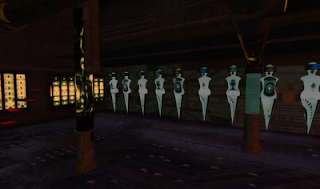A couple of weeks ago, Amase Levasseur opened
Originalia, a sim "dedicated to art in SL." Unfortunately I haven't discovered any further information on Amase's aims, but the inaugural show "Reverie" consists of two exhibits of pictures and paintings by RAG Randt and Em Larsson (the former inside a gallery, the latter scattered along a pathway and appearing as you approach); and two quarter-sim immersive builds, one by Scottius Polke, the other by Eliza Wierwight. I'm only going to discuss the builds, since immersive works are where my interest lies.
Scottius is well known for his whimsical creations "mushROOM" and "Lunamaruna." "The Docks" (his installation at Originalia) has some of those elements, but its atmosphere contrasts dramatically: this is a spooky, possibly sinister place. A faint fog slightly clouds the imagery, colors are muted, there is little sound. Scotti's work always has a children's-book quality, which emerges here as a simplified realism laced with just enough exaggeration to tip it into fantasy ... plus a couple of monsters. The imagery is also startlingly flat. Even though it's a three-dimensional immersive environment, no matter where you look the picture looks like a drawing or a watercolor painting. The lack of shadowing and the use of mist contribute to this flattening. There is also an odd side effect. Although many builds don't make much use of sound, and "The Docks" does use sound to some extent (you can hear your footsteps as you cross the bridge into it, and there's a low ambient hum throughout), somehow this work feels immersed in an eerie silence. The monsters proudly standing on a dock seem to be surveying a location long abandoned and decayed -- and yet not so, for someone still lives in the house, from which light is streaming. Have the creatures just arrived? Has the occupant chosen simply to accept their presence and coexist with them?
(Click images to enlarge.)
As you can see, there are a few interactive elements in "The Docks": a rowboat with a lobster trap, an innertube (which you can rez from the dock), and not shown, an uneasy sleep in a bunk inside the house.
The disturbing tone continues in Eliza's "Aria." Her notecard describes it as "a whimsical nocturne engraved with all the aesthetic & charm of the River Styx," and the irony of that statement carries through in the installation itself, in which Eliza conjoins her meticulous, even luminous craftwork with an undefinable sense of menace and scenes that suggest unearthly sacrifice, all enveloped in an eroticism that is emboldened by its sacred anonymity and intensified by its leash. One thinks of Venetian carnival masks, in the way they arise in the films
Amadeus and
Eyes Wide Shut; indeed, many of the human figures in "Aria" wear masks, and there is something masklike about the gowns set around the scene. In one image, a woman's eyelids are pressed shut by death's head coins. Not for nothing does Eliza advise the visitor to use the gloomy Bristol windlight settings (if you use Phoenix, they should set in automatically).
(Click images to enlarge.)
In contrast to the flatness and ominous quiet of "The Docks," "Aria" is highly tactile and sound-rich -- but in ways that connote an unsettling surfeit of pleasures. A few of the objects emit sounds (a vase even issues notes that drift in the wind); there is a music stream; there is a video stream with its own music, along with images of a score by "W.A.M.," i.e., Wolfgang Amadeus Mozart (again recalling
Amadeus). The auditory elements pile up and collide into a cacophony of beauty.
Scattered about, many of them hanging in the air and often streaming blue lights, are numerous huge keys. Keys to what? Are they punning musical keys? But they have no sounds themselves. The women holding an infant aloft -- are they preparing to make an offering of their child, or like Achilles's mother, perhaps to dip it in the River Styx in order to give it invulnerability? These are only a few of the questions one asks to unlock the secrets of "Aria." There are innumerable narratives we might drape around it. None, perhaps, may explain it.
"The Docks" and "Aria" are exceptional installations. I don't know how long they'll be on view (I'm guessing a few months), but I recommend you go soon. You may want to go often.






























